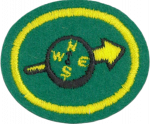Difference between revisions of "AY Honors/Orienteering/Answer Key/es"
(Created page with "</noinclude> <!-- 7. Conocer dos métodos para corregir la declinación. -->") |
(Created page with "</noinclude> <!-- 8. Ser capaz de orientarse por sí mismo y un mapa, por inspección y por una brújula. -->") |
||
| Line 175: | Line 175: | ||
{{ansreq|page={{#titleparts:{{PAGENAME}}|2|1}}|num=8}} | {{ansreq|page={{#titleparts:{{PAGENAME}}|2|1}}|num=8}} | ||
<noinclude></noinclude> | <noinclude></noinclude> | ||
| − | <!-- | + | <!-- 8. Ser capaz de orientarse por sí mismo y un mapa, por inspección y por una brújula. --> |
| − | |||
<noinclude></noinclude> | <noinclude></noinclude> | ||
Revision as of 02:42, 31 January 2021
| Orientación | ||
|---|---|---|
| Asociación General
|
Destreza: 2 Año de introducción: 1956 |
|
Requisitos
Template:Division variant (GC)/es
|
La especialidad de Orientación es un componente de la Maestría Vida Primitiva. |
|
La especialidad de Orientación es un componente de la Maestría Recreación. |
| Conexión Logros para la Investidura: Esta especialidad está relacionada con los requisitos de Logros para la Investidura para VIAJERO AL AIRE LIBRE Vida al Aire Libre que requiere completar esta especialidad o una de 4 otras, no obtenida previamente. |
Para esta especialidad, necesitará una brújula militar como la del enlace hacia Amazon. También necesitará mapas topográficas que se pueden descargar gratuitamente o se pueden comprar.
1
2
3
4
4a
4b
4c
4d
4e
4f
4g
4h
4i
4j
4k
5
6
7
8
9
Resection is a method of using a compass and a map to determine your current position. The first step is to find a feature of the landscape that you can also identify on the map. This could be a mountain peak, an intersection, a bridge, or even a utility pole (some topographic maps mark where high-voltage lines are, as well as the position of the poles that hold them up). The closer these two landmarks are to 90° offset from one another, the more accurate the resection will be. For instance, if the first landmark is at 115°, choose the second one as close to either 205° (115°+90°) or 25° (115°-90°) as you can. This is not a hard and fast rule, and the prominence of the landmark may well be more important than the 90° offset. Once you have shot an azimuth to the first landmark, calculate the back azimuth, and plot a line on your map from the landmark towards (and past) your current position (which should be somewhere on that line). Be sure to correct for declination when plotting this line. Then shoot the azimuth of the second landmark, and plot it's back azimuth on the map as well, again correcting for declination. If your readings are accurate and your plotting was done carefully, your current position should be very close to where these two lines intersect.
10
Referencias
- Categoría: Tiene imagen de insignia
- Adventist Youth Honors Answer Book/Honors/es
- Adventist Youth Honors Answer Book/es
- Adventist Youth Honors Answer Book/Skill Level 2/es
- Categoría: Libro de respuestas de especialidades JA/Especialidades introducidas en 1956
- Adventist Youth Honors Answer Book/General Conference/es
- Adventist Youth Honors Answer Book/Unknown/es
- Adventist Youth Honors Answer Book/Unknown/Primary/es
- Adventist Youth Honors Answer Book/Stage 0/es
- Adventist Youth Honors Answer Book/Wilderness Master Award/es
- Adventist Youth Honors Answer Book/Recreation Master Award/es
- Adventist Youth Honors Answer Book/IAConnection/es


